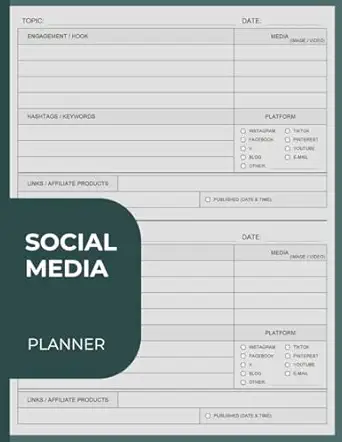The Ultimate Guide to Creating a Content Marketing Calendar
Introduction
Understanding the Importance of a Content Marketing Calendar
Creating a content marketing calendar is essential for any business looking to streamline its marketing efforts. It helps you plan, organize, and execute your content strategy effectively. By having a clear roadmap, you can ensure that your content aligns with your goals and resonates with your audience. A well-structured calendar not only keeps you on track but also enhances collaboration among team members. In this guide, you’ll learn about the key components of a content marketing calendar, its benefits, and how to create one that works for you.
What is a Content Marketing Calendar?
Definition and Purpose
A content marketing calendar is a tool that outlines what content will be published over a specific period. This could range from daily social media posts to monthly blog articles or quarterly email newsletters. The primary purpose of this calendar is to provide clarity on when and where each piece of content will be shared. It serves as both an organizational tool and a strategic guide for your marketing efforts.
Key Components of an Effective Calendar
An effective content marketing calendar includes several key components:
- Content Type: Specify whether it’s a blog post, video, social media update, etc.
- Publication Date: Clearly mark when each piece will go live.
- Target Audience: Identify who the intended audience is for each piece.
- Promotion Strategy: Outline how you plan to promote the content after publication.
- Performance Metrics: Include space to track engagement metrics like views or shares.
These elements work together to ensure that all aspects of your content strategy are covered.
Benefits of Using a Content Marketing Calendar
Improved Organization and Planning
One major benefit of using a content marketing calendar is improved organization. With everything laid out in advance, you can easily see what needs to be done at any given time. This helps prevent last-minute scrambles for ideas or panic over missed deadlines. When everyone knows their responsibilities ahead of time, planning becomes much more manageable.
Enhanced Team Collaboration
A shared calendar fosters better communication within your team. Everyone involved in the project can see what others are working on and when things are due. This transparency encourages collaboration and reduces overlap in tasks—ensuring that everyone contributes effectively without duplicating efforts.
Consistency in Content Delivery
Consistency is crucial in building trust with your audience. A well-maintained calendar ensures that you’re regularly delivering fresh content across various platforms. Regular updates keep your brand top-of-mind for consumers while also improving SEO rankings through consistent keyword usage.
Steps to Create Your Content Marketing Calendar
Define Your Goals and Objectives
Before diving into creating your calendar, it’s vital first to define clear goals and objectives for your content strategy. Are you aiming to increase website traffic? Do you want more social media followers? Setting specific targets will help shape the type of content you’ll produce and how often you’ll publish it.
Identify Your Target Audience
Understanding who you’re creating the content for is equally important as knowing why you’re doing it. Spend some time researching demographics such as age group, interests, location, etc., which can inform what topics resonate best with them.
Choose the Right Tools and Platforms
Selecting tools that fit both your team’s needs and budget can make managing the calendar much easier. Options include Google Sheets for simplicity or specialized software like Trello or Asana designed specifically for project management tasks related to marketing calendars.
Types of Content to Include in Your Calendar
Blog Posts and Articles
Blog posts are foundational pieces in any digital marketing strategy because they provide valuable information while boosting SEO efforts through targeted keywords relevant to user searches.
Social Media Updates
Social media platforms allow brands direct interaction with their audiences; thus including regular updates tailored per platform (Facebook vs Instagram) ensures maximum engagement potential based on user behavior patterns observed there.
Email Newsletters
Email newsletters serve as excellent ways not just for sharing new blog posts but also highlighting promotions or upcoming events—keeping subscribers informed about what’s happening within the company directly via their inboxes!
Best Practices for Maintaining Your Content Marketing Calendar
Regular Review and Update
Your initial plan may need adjustments along the way due primarily either due changes within industry trends affecting consumer preferences—or even internal shifts regarding resource availability! Schedule regular reviews (monthly/quarterly) so necessary tweaks don’t fall by wayside unnoticed!
Analyzing Performance Metrics
Tracking performance metrics allows insight into what’s working versus what isn’t! Use analytics tools available through platforms like Google Analytics combined alongside social media insights provided natively by those sites themselves—this data informs future decisions regarding types/topics chosen next round!
Adapting to Trends and Feedback
The digital landscape evolves rapidly; therefore remaining adaptable means being open-minded towards incorporating feedback received from audiences along with recognizing emerging trends relevant today! Flexibility should always remain part-and-parcel throughout entire process ensuring relevance maintained consistently!
Common Mistakes to Avoid When Creating a Content Marketing Calendar
Overloading on Content
While consistency matters greatly—it’s equally important not overwhelm yourself/team members by cramming too much into one month/week! Quality trumps quantity every single time; hence prioritize producing fewer high-quality pieces rather than numerous mediocre ones instead!
Lack of Flexibility
Sticking rigidly without room left open allows unforeseen circumstances arise unexpectedly (like trending topics!) which might warrant immediate attention instead—thus leaving flexibility built-in enables quick pivots whenever necessary maintaining relevancy overall!
Ignoring Audience Engagement
Failing engage actively back-and-forth leads disengagement ultimately resulting lower retention rates long-term! Make sure incorporate opportunities encourage dialogue between brand/audience fostering community spirit around offerings provided enhancing loyalty levels achieved thereafter too!
Conclusion
Recap of the Importance of a Well-Structured Content Marketing Calendar
In summary, creating an effective content marketing calendar helps improve organization while enhancing collaboration among team members—all leading towards consistent delivery engaging materials tailored specifically toward target audiences identified initially at outset stages established earlier down road ahead! By avoiding common pitfalls associated therein plus adhering best practices outlined here—you’ll set yourself up successfully navigate complexities modern-day digital landscape successfully moving forward confidently onward journey ahead!
📢 Explore More: Continue Your Journey!
If this article helped you understand how crucial planning is in digital strategies check out How To Measure The Success Of Your Digital Campaigns! It covers essential metrics helping you gauge effectiveness better while optimizing future campaigns accordingly.














![NEEWER 55W 18"/45cm Ring Light Kit [New Version], 5600K Dimmable ...](https://m.media-amazon.com/images/I/414QLqvZWLL.jpg)








